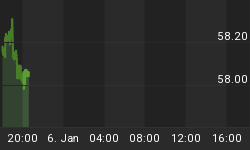The data used for this short paper is the 3-month US Treasury Bill: Secondary Market Rate, which can be downloaded from the St. Louis Federal Reserve FRED2 System (so you can follow at home).
http://research.stlouisfed.org/fred2/series/TB3MS/116
The chart associated with this paper can be found here
http://www.geocities.com/champeaudavid/3mmonthly.gif
Looking at the data in the post World War II time period we see an incredible symmetry from 1947 to the present day. I would like to concentrate on the "bottoms" that has been seen in the 3-month interest rates as they tell an interesting story.
During the war 3-month rates ("rates") remained at .38%. In July 1947 they began to rise. They rose into 1953 and then fell into 1954 making a low in June 1954 at .64%. They rose again into 1957 and then dropped again making a low in June 1958 at .83%. So we could say that they made a double bottom 4 years apart.
From 1957 rates generally rose making a top in early 1970 and then fell into 1972 making a low at 3.2% in February 1972, roughly 14 years after the last bottom in 1958.
From 1972 rates went up and down again and in December 1976 made another bottom at 4.35%, 4 years after the last bottom.
Rates then went much higher as most of us remember and they made a top in May 1981 at 16.3%. This is about 27 years from the 1954 bottom and 23 years from the 1958 bottom.
Rates started to fall and made a bottom in Oct 1986 at 5.18%. This is a little more than 5 years from the all-time high and shows symmetry with the 1976 bottom.
The next bottom came in October 1992 at 2.86%. This is 11 years from the all-time high and 20.5 years from the 3.2% low in 1972. Here we have two lows near 3% in a span of 20.5 years split almost perfectly down the middle by the all-time high of 1981. Excellent symmetry.
The last low came in January 2004 at .88%, 46 years from the 1958 low at .83%. This 46 years is again split almost perfectly by the 1981 all-time high, 23 years on each side give or take a few months.
Putting all this coincidental symmetry together, we can expect to see 3-month interest rates below 1% sometime around 2008, marking a 4-year double bottom as was seen in the 1950s. This would be 54 years from the 1954 bottom and again split perfectly in half by the 1981 all-time high.
Is there anything to this? Well, we can only look at today's bond markets to draw a clue.
What we see today in the industrialized world are inverted yield curves in the UK and Australia, effectively 0% in all maturities in Japan, and a shrinking yield curve in the US. The markets in both the UK and Australia are signaling rate CUTS later this year.
In the US, some of us have known for a long time that Alan Greenspan is always way behind the markets and he always over does things to the point of creating a crisis or two somewhere. This time should be no different. The global bond markets are calling for lower short rates and he is still raising rates.
Looking at the chart of 3-month rates the "resistance" level is in the 3% range. Fed Funds are at 3% and going to 3.25% at the end of the month. But as of yesterday 3-month TBill rates are at 2.86%. The market is trying to tell Greenspan to ease up.
The next "soft spot" in the global economy will force the central bankers to cut rates again. This may be the last hurrah in the race to zero. After the next round of cuts they will have nowhere to go. The industrialized world will be saturated with debt and many, many industries will have a huge over capacity issue.
Each of the last 3 decades, 70s, 80s and 90s, has finished with a "bang" in a particular market or asset class. The 70s ended with the commodity blowoff in the 1st quarter of 1980. The 80s ended with the Nikkei hitting 39,000+ on December 29, 1989. The 90s ended with the NASDAQ bursting in March of 2000. If global short rates go to near zero in 2008-2010, which market/asset class will benefit the most? Will it be commodities, led by energy, as many people believe? Will it be bonds? Bill Gross thinks the US 10-year is headed to 3.5%. Could it follow Japan to 1.25%?
This blowoff move in 2009-2010 would also fit with my previous paper, Changes in the Dollar, as the end of decade bubble will force a major change in the global monetary system in the next decade, especially if global bonds are all near 0%.
Get ready for lower global short rates and look for global speculation to run rampant.
















